SYSTEM DESCRIPTION FUNCTION OF COMPONENTS (a) The intelligent clearance sonar system consists of the following components: |
Component | Function | |
Clearance Warning ECU Assembly |
- Sends the drive force request signals and control status signals to the ECM and skid control ECU.
- Sends the multi-information display request signals and ICS OFF
indicator light illumination request signals to the combination meter
assembly.
- Determines the distance between an obstruction and the vehicle based on the signals from the ultrasonic sensors.
- Sounds the No. 1 clearance warning buzzer and No. 2 clearance warning buzzer in accordance with the control status.
| | Steering Pad Switch Assembly
- Multi-information Switch |
Enables,
disables or cuts off the operation of the intelligent clearance sonar
system by transmitting the switch operation signal to the combination
meter assembly. | | ECM |
- Sends the engine speed, accelerator pedal opening angle signal, shift
status signal and drive force signal to the clearance warning ECU
assembly via CAN communication.
- Receives the drive force request signals and control status signals from
the clearance warning ECU assembly via CAN communication.
| | Combination Meter Assembly
- Multi-information Display - ICS OFF Indicator - Meter buzzer |
- Receives information from ultrasonic sensors via the clearance warning
ECU assembly and displays it on the multi-information display.
- Receives the multi-information display request signals via CAN
communication and displays the control status of the intelligent
clearance sonar system on the multi-information display.
- Illuminates the ICS OFF indicator light when the intelligent clearance
sonar system is off and blinks it when the intelligent clearance sonar
system is malfunctioning.
- Sends the intelligent clearance sonar system on/off signal to the
clearance warning ECU assembly via CAN communication. The intelligent
clearance sonar system can be turned on or off using the steering pad
switch assembly.
- Sounds the meter buzzer when the intelligent clearance sonar system is operating or malfunctioning.
| | Headup Display*
- Meter Mirror Sub-assembly |
Displays
the control status of the intelligent clearance sonar system based on
the signals received from the clearance warning ECU assembly via CAN
communication. | | Stop Light Switch Assembly |
Detects if the brake pedal is depressed and outputs a signal to the skid control ECU. | |
Skid Control ECU |
- Sends the master cylinder pressure signal and wheel speed signals to the clearance warning ECU assembly via CAN communication.
- Receives the drive force request signal and control status signal from the clearance warning ECU assembly via CAN communication.
| | Steering Sensor |
Sends the steering angle signal to the clearance warning ECU assembly via CAN communication. | |
Airbag ECU Assembly
- Yaw Rate and Acceleration Sensor
| Sends the yaw rate and acceleration sensor signal to the clearance warning ECU assembly via CAN communication. |
- Front Speed Sensor (LH/RH)
- Rear Speed Sensor (LH/RH)
| Sends the wheel speed signals to the skid control ECU. | |
Park/neutral Position Switch Assembly |
Sends the shift state signal to the ECM. | |
Ultrasonic Sensor | Detects the distance between the vehicle and an obstacle. |
- No. 1 Clearance Warning Buzzer
- No. 2 Clearance Warning Buzzer
| Sounds upon receiving signals from the Clearance Warning ECU Assembly. | |
Accelerator Pedal Sensor Assembly |
Sends the accelerator pedal opening angle signal to the ECM. | |
Main Body ECU (Multiplex Network Body ECU) |
Sends the driver seat belt signal to the clearance warning ECU assembly. | |
Air Conditioning Amplifier Assembly |
Sends the ambient temperature signal to the clearance warning ECU assembly. | |
Blind Spot Monitor Sensor (LH/RH) | Sends blind spot monitor system status signals to the clearance warning ECU assembly via CAN communication. |
- *: w/ Headup Display System
OPERATION CONDITIONS (Intelligent Clearance Sonar System) (a) Driving torque restriction control
(1) Initiation Condition (When all of the following conditions are met, the driving torque restriction control is performed.)
- The intelligent clearance sonar system is turned on.
- An obstruction is detected by an ultrasonic sensor.
- The vehicle speed is 15 km/h (9 mph) or less.
- Collision is avoidable if emergency braking is performed by the driver.
(2) Cancellation Condition (When any of the following conditions are met, driving torque restriction control is cancelled.)
- The intelligent clearance sonar system is turned off.
- No obstruction is detected by the ultrasonic sensors.
- A possible collision is avoided.
(b) Brake Control (1) Initiation Condition (When all of the following conditions are met, brake control is performed.)
- Driving torque restriction control is performed.
- A collision is likely even if emergency braking is performed by the driver.
(2) Cancellation Condition (When any of the following conditions are met, driving torque restriction control is cancelled.)
- The intelligent clearance sonar system is turned off.
- The brake pedal is depressed after the vehicle is stopped by brake control.
- Approximately 2 seconds have elapsed since the vehicle was stopped by brake control.
- No obstruction is detected by the ultrasonic sensors.
(c) Others
- When brake control is performed, the intelligent clearance sonar system
turns off automatically. The intelligent clearance sonar system turns on
again when no obstructions are detected by the ultrasonic sensors, the
shift lever is moved from D to R or is moved from R to D, the engine
switch is turned off and then turned on (IG), or by using the settings
screen on the multi-information display. Intelligent clearance sonar
system operation

OPERATION CONDITIONS (Rear Cross Traffic Auto Brake Function) (a) Driving torque restriction control
(1) Initiation Condition (When all of the following conditions are met, the driving torque restriction control is performed.)
- The intelligent clearance sonar system is turned on.
- The shift lever is in R.
- When a vehicle is approaching the right or left at the rear of the vehicle.
- The vehicle speed is 15 km/h (9 mph) or less.
- When a collision with an approaching vehicle is imminent
(2) Cancellation Condition (When any of the following conditions are met, driving torque restriction control is cancelled.)
- The intelligent clearance sonar system is turned off.
- When the vehicle approaching the right or left at the rear of the vehicle is no longer detected.
- A possible collision is avoided.
(b) Brake Control (1) Initiation Condition (When all of the following conditions are met, brake control is performed.)
- Driving torque restriction control is performed.
- A collision is likely even if emergency braking is performed by the driver.
(2) Cancellation Condition (When any of the following conditions are met, driving torque restriction control is cancelled.)
- The intelligent clearance sonar system is turned off.
- The brake pedal is depressed after the vehicle is stopped by brake control.
- Approximately 2 seconds have elapsed since the vehicle was stopped by brake control.
- When the vehicle approaching the right or left at the rear of the vehicle is no longer detected.
(c) Others
- When brake control is performed, the intelligent clearance sonar system
turns off automatically. The intelligent clearance sonar system turns on
again when no obstructions are detected by the ultrasonic sensors, the
shift lever is moved from D to R or is moved from R to D, the engine
switch is turned off and then turned on (IG), or by using the settings
screen on the multi-information display. Rear cross traffic auto brake
function operation

CASES OF UNNECESSARY INTELLIGENT CLEARANCE SONAR SYSTEM OPERATION
(a)
In the following situations, the intelligent clearance sonar system may
operate even when there is no possibility of a collision: (1) Environmental influence
(2) Influence from the weather

- In severe weather such as fog, snow or a sandstorm.
- Foreign matter such as snow, ice or mud is attached to an ultrasonic
sensor. (The system returns to normal when the foreign matter is
removed.)
- When there is a downpour, or water is splashing on the vehicle.
- Water is covering an ultrasonic sensor due to a flooded road.
(3) Influence from other ultrasonic waves
- When ultrasonic waves are received from the horn or parking sonar system
of another vehicle, a motorcycle engine, or the air brakes of a large
vehicle.
- Electronic components such as a backlit license plate (especially
fluorescent types), fog lights, a fender pole or a wireless antenna are
installed near an ultrasonic sensor.
(4) Changes in the vehicle.
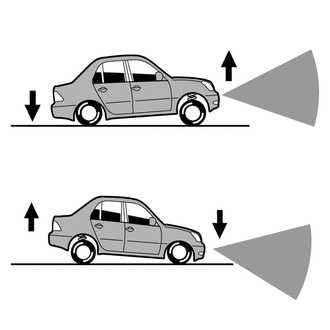
- The height of the vehicle has drastically changed due to loading (the nose tilts up or down).
- The vehicle is significantly tilted.
- An ultrasonic sensor is misaligned due to a collision, etc.
(5) Others 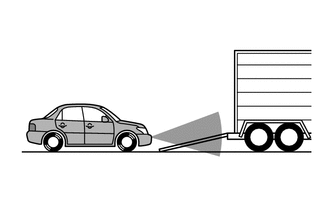
- The vehicle is being loaded onto a ship, truck or other transport vessel.
- The vehicle is being operated on a drum tester such as a speedometer
tester, brake/speedometer combination tester or chassis dynamometer.
- When the vehicle is being towed.
CASES OF UNNECESSARY REAR CROSS TRAFFIC AUTO BRAKE FUNCTION OPERATION
(a)
In the following situations, the rear cross traffic auto brake function
may operate even when there is no possibility of a collision:
- When a vehicle is travelling along a road that is located extremely close to a parking space.

- When a vehicle is entering an adjacent parking space.

- When an object is passing extremely close to the vehicle.
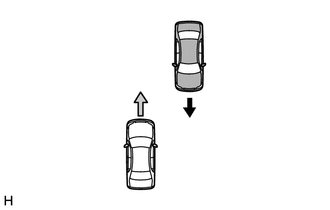
- When there is a metal object behind the vehicle such as a guard rail,
wall, traffic sign or parked vehicle that easily reflects radio waves.

MULTI-INFORMATION DISPLAY AND HEADUP DISPLAY (w/ Headup Display System)
(a) Intelligent clearance sonar system display
- The intelligent clearance sonar system uses the multi-information
display in the combination meter assembly, the meter mirror sub-assembly
and ICS OFF indicator light to indicate the operation status of the
system.
(b) Intelligent clearance sonar system operation status display
- When the operation conditions are met, the clearance warning ECU
assembly sends display or illumination request signals to the
combination meter assembly, combination meter mirror ECU and ICS OFF
indicator light. The clearance warning ECU assembly also sends buzzer
sound request signals to the combination meter assembly.
 (c) Intelligent clearance sonar system warning display
- When operation of the intelligent clearance sonar system is temporarily
suspended due to a malfunction or dirty ultrasonic sensor, a message is
displayed on the multi-information display in the combination meter
assembly, the ICS OFF indicator light blinks and the buzzer sounds.
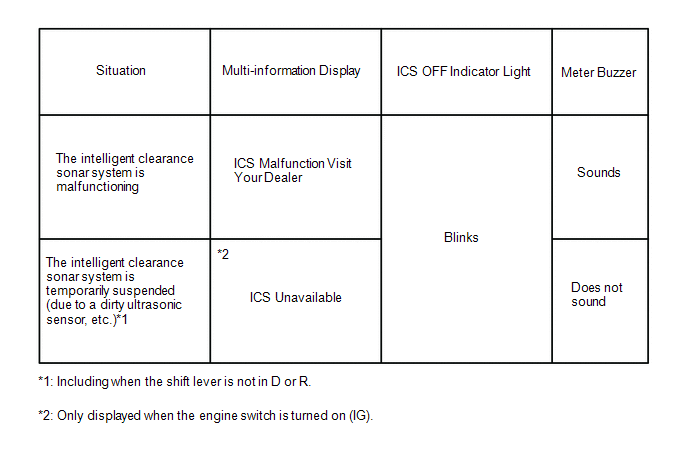 (d) Intelligent clearance sonar system off display
- When the intelligent clearance sonar system is off, the ICS OFF indicator light illuminates.
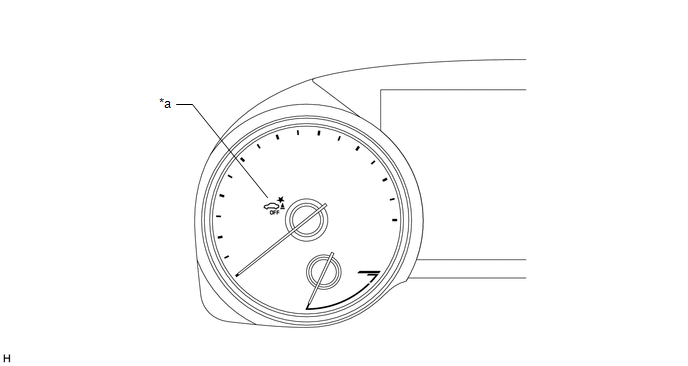
|





